This was published 1 year ago
‘There’s nowhere for them to go’: When girls are booted out of football
At 13, Phoebe Guppy is at a crossroads. Travel over an hour for footy training, or give up the game she loves. Daisy Pearce has been at the crossroads before her, and many more will follow.
By Hannah Kennelly
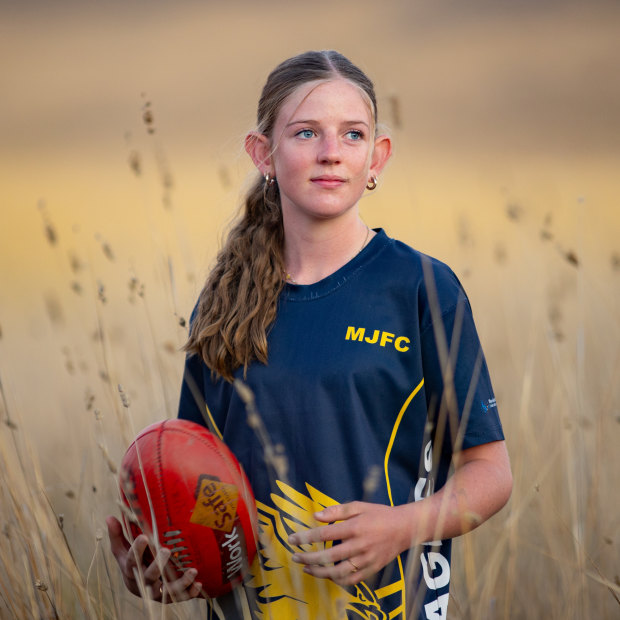
Phoebe Guppy, 13, has been playing Aussie Rules since she was six.Credit: Simon Schluter
Phoebe Guppy keeps her eyes focused, digging her mud-splattered boots into the damp ovals of Mansfield Recreation Reserve.
At the trill of the whistle, the 13-year-old springs forward, zigzagging through a line of fluorescent cones while dodging a charging teammate, then booting her Sherrin toward the goals.
She turns to high-five her teammates, smiling. Born in a country home where barely an hour passes without mention of football, training at ‘the rec’ has been the most natural part of her routine, she says, since she was six years old.
“I’ve played netball and basketball, but footy has always been my favourite,” she says, drinking water between drills. “I just love every part of it.”
Phoebe plays for the Mansfield Eagles Junior Football Club in regional Victoria’s sweeping High Country and is the only girl in the mixed under-14s team.
But despite her devotion, 2024 will be her last year in Mansfield’s blue and gold guernsey.
According to the AFL’s National Policy Handbook, she explains, players older than 14 are asked to compete in an age group that accords with their gender. For teenage girls living in regional Victoria, that often means finding a new team in an entirely different town - and four years in limbo to continue to play the game they love.
To continue to play, Phoebe must brace for a two-hour round trip to Wangaratta - the nearest youth girls’ team. “I really want to keep playing,” she says softly, then adds: “But yeah, it’s a pretty far way to go for footy.”
By any measure, Aussie Rules is the No.1 sport in Victoria, especially in the state’s rapidly growing regions, where the legacy and the dynamics of the sport - and the local footy club - continue to wind through the community. For some, the club provides the only pathway to professional careers in AFL or AFLW.
Across regional Victoria, there are more than 520 local football clubs - roughly half of the state’s total participation base. Fewer than half of these regional clubs field single-sex teams for girls over the age of 13.
According to the AFL, girls now make up one in four Victorian Auskickers. But pathways for regional Victorian girls, once they ‘age out’ of junior football, are limited.
An old dream, a dedicated dad and a 400-kilometre weekly commute
Hannah Berriman has spent the past two years travelling from Bonnie Doon to Shepparton for footy training and games, adding a weekly average of 394 kilometres to her white Toyota Hilux.
“When you live regionally, and you’re a girl who loves footy, that’s kinda how it is.”
Hannah Berriman
She occasionally trains with the Bonnie Doon men’s team on weeknights when she cannot make the 80-minute commute to Shepparton. The 18-year-old carpentry apprentice has won back-to-back premierships with the Shepparton Swans girls’ team, a team she has learned to love, but admits the travel can be exhausting.
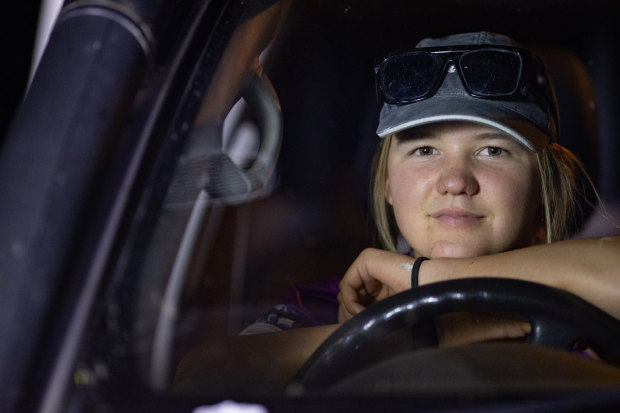
Hannah Berriman travels over an hour to footy training in Shepparton.Credit: Simon Schluter
“All the driving can be a bit intense” she explains. “But when you live regionally, and you’re a girl who loves footy, that’s kinda how it is.”
Across the Hume Highway, at WJ Findlay Oval in Wangaratta, Jess Whitehead is sprinting towards the goalposts, a silver whistle between her fingers.
The Wangaratta Rovers under-17s girls’ coach is late to her team’s weekly Thursday training session but arrives in time for handball drills. She greets her team with a smile, but a flicker of irritation crosses her face.
Earlier that morning, Jess was told her girls would need to vacate the oval and give up their training slot to make way for the men’s team. They needed to prepare for their Good Friday match, she was told. After voicing her objections, and settling for a shorter, earlier session, Jess was told the team could still train at WJ Findlay.
“Bit of a miscommunication between teams,” she explains. “They’ve got their big match coming up, so they take precedence. It’s a genuine mistake … but it’s frustrating, probably shows women’s and girls’ footy still has a fair way to go.”
A third of Jess’ under-17 girls’ team, who play in the AFL North East Border Female Football League, lives outside Wangaratta. The last-minute decision to make way for the men’s team with an earlier time slot has meant that as well as Jess, many are late to training.
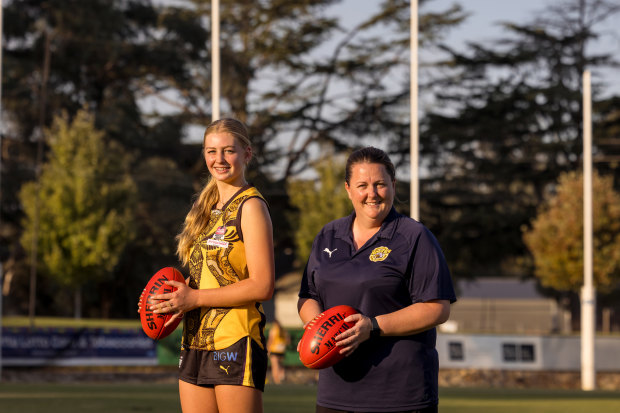
Wangaratta Rovers coach Jessica Whitehead with one of her players, 16-year-old Amelie Thompson.Credit: Jason Robins
“We’ve got heaps of girls that travel for an hour or more to get to Wangaratta for footy training so as a coach, you’ve got to be flexible,” she says.
“I’m lucky that Dad can drive me to Wangaratta because some girls might not have that.”
Amelie Thompson
A young girl races onto the field, shouting a jumble of apologies.
“I’m sorry Jess!” yells Amelie Thompson, 16, who has travelled more than an hour to get to training from Wandiligong, a small gold mining town famous for its auburn autumn foliage and notable AFL lineage.
The 16-year-old typically spends between five and seven hours each week driving to training.
“I just love footy, the running, the tackling and the intensity of it is awesome,” she says. “I’m lucky that Dad can drive me to Wangaratta because some girls might not have that.”
Amelie used to play in a junior mixed team for Bright Football Club, a mere eight-minute drive from her family home. When she turned 14, her father Craig applied for dispensation for her to keep playing with the boys. The request was denied. There was, the AFL told them, “an existing female league in the region”.
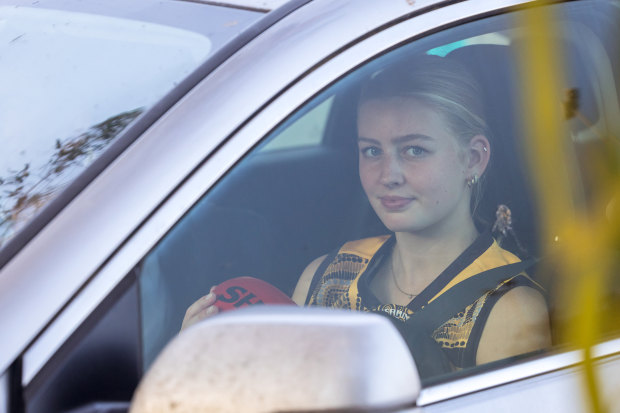
Amelie Thompson’s request to keep playing with male players was knocked back.Credit: Jason Robins
The nearest female league in Amelie’s age bracket was the Alpine Lions, in Whorouly, a 48-minute drive from Wandiligong. So that’s where Amelie played - until they folded in March 2022.
The next feasible option was the Wangaratta Rovers, a 2½-hour round trip from home.
Spotify playlists and carpooling with teammates make the winding drives bearable, says Amelie. Occasionally, she uses the time to lodge hours for her learners’ permit. Most often, though, Amelie just sleeps.
“I get home from training after 9.30pm plus I’ve got weekend games, plus regular school so I can get pretty tired.”
But dedication has paid off. Amelie was selected for the Murray Bushrangers Talent League last year – a common recruiting ground for the AFL and AFLW. She now trains with the Bushrangers twice a week (also in Wangaratta) and once a fortnight in Wodonga. For fun, she also still trains with the Rovers when she can.
The talent league selection brings her one step closer to wearing a Collingwood guernsey, a long-held dream. “Playing for the Pies would be pretty epic, so I want to do everything possible to achieve that.”
Jess-endon, Daisy Pearce and ‘the travel obstacle’: The story of two coaches
Whitehead grew up playing Auskick and backyard footy in Wangaratta.
Her adoration for the game even inspired a nickname. “My family and friends call me ‘Jess-endon’ because I pretty much know every single thing about the Bombers,” she laughs.
Whitehead excelled in Wangaratta’s mixed Aussie rules teams, but quit after she turned 13. “I was too old to play with the boys and my parents didn’t have the capacity to drive me to Melbourne, so I just stopped.”
In 2018, she co-founded the Wangaratta Rovers women’s team with fellow coach Celia Piesse – the first women’s side in the club’s history. Since then, the club has grown to include teams for under 12s, under 14s and under 17s.
Whitehead says while regional footy opportunities for women and girls have grown “tremendously” over the past decade, “the travel obstacle” remains.
“I was too old to play with the boys and my parents didn’t have the capacity to drive me to Melbourne, so I just stopped.”
Jess Whitehead
Long-distance travel is a well-documented consequence of living regionally. Many young people living in the country, regardless of their gender, travel lengthy distances over the weekend to play sport. But travel pressures are “more likely” to impact female footy players, Jess says.
“For example, a male footy player growing up in Bright can stay at his home club or travel to neighbouring clubs in Myrtleford or Yackandandah,” she says. “A female player in Bright has to drive past all of those clubs for over an hour to get to her closest option in Wangaratta. That’s just to attend training, that’s not even including games.”
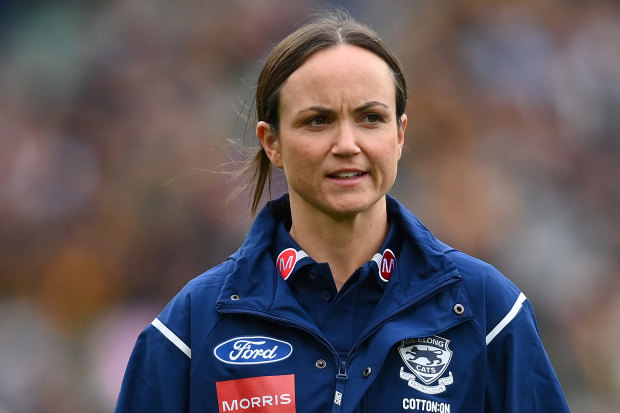
Daisy Pearce moved to Melbourne as a kid to be closer to her mum - and to footy.Credit: Getty Images
If Amelie’s story sounds familiar, it’s probably because you read something like it about Daisy Pearce. The AFLW premiership player turned West Coast Eagles coach grew up in Wandiligong, where footy talk fell loosely and naturally across school yards, offices, and family dinners.
“Regional footy clubs are the heartbeat of communities,” Pearce explains. “Footy was such an important vein … a vital thread that flowed through my family. As a kid, I feel like all my happiest memories revolved around being at the local club, playing footy in the backyard or inside the kitchen.”
Pearce played with Bright Junior Football Club’s mixed teams until she was 14, but was not allowed to play beyond the under 15s team. She admits this “somewhat contributed” to her move to Melbourne.
“My mum was living in Melbourne, so I wanted to be closer to her and my siblings, but part of it was definitely not being able to play footy in Bright any more.”
Daisy said opportunities for girls in footy had improved incredibly over the past two decades, but said regional Victoria was still “a fair way behind” metropolitan Melbourne.
“The travel ... for girls in regional areas isn’t ideal or fair,” she says. “But if you compare it to what it was like 20 years ago, you didn’t have anywhere to go, let alone travel. But yeah, there’s definitely a lot more room to grow and more barriers to be broken.”
‘There’s nowhere for these girls to go’
The Age contacted football clubs across regional Victoria and spoke with a dozen football presidents, coaches and parents as well as past and present female Aussie rules players.
All acknowledge the accessibility and availability of girls’ and women’s footy as an ongoing issue, blaming several factors.
Many football presidents highlighted the significant impact of the coronavirus pandemic on male and female participation numbers for regional leagues. During the pandemic, several women’s and youth girls’ teams folded from 2020 to 2023 in areas like Benalla, Gippsland, Whorouly, Tyrendarra and Echuca.
“Why should those girls keep playing, why invest so much time building skills when they know there’s no place for them in two years’ time?”
John Guinan
A lack of fierce competition leads young girls to netball instead of footy, Bright Junior Football president Nick Toy says.
“The strength of our junior netball programs attract most of our young female athletes but the major factor [deterring girls from footy] would have to be the lack of a truly local competition which allows girls to regularly train and play without extensive travel,” he says.
Over in north-central Victoria, Kyabram Football Club president John Guinan sees many young girls in Auskick and junior teams but has noticed a steep drop-off in numbers at around 11 years of age. Kyabram does not have any youth girls’ or women’s sides.
“Why should those girls keep playing, why invest so much time building skills when they know there’s no place for them in two years’ time?” he says. “We want more girls to play footy and that’s admirable. But we’re sending pretty mixed messages when there are no pathways for them to keep playing.”
On the banks of the Murray River in Cobram, Ian Foster says the “lumped age bracket” for youth girls’ teams can sometimes be a deterrent for concerned parents and players.
His daughters, 12-year-old Isabelle and 14-year-old Willow, train with Katamatite Football Club’s mixed teams and also travel to Wangaratta to play for the Rovers – a trip that typically takes more than an hour.
Barooga Football Club recently announced the formation of a youth girls’ team for players aged 13 to 17. The new team is much closer to the Fosters’ home in Cobram, but Ian is reluctant.
“It’s a massive age group, so the skill set and overall play is at a lower level,” he explains.
“Isabelle wants to play professionally, so we obviously don’t want her to sustain injuries from playing against older girls.
“We want her to have the best shot possible, and at the moment, that means travelling.”
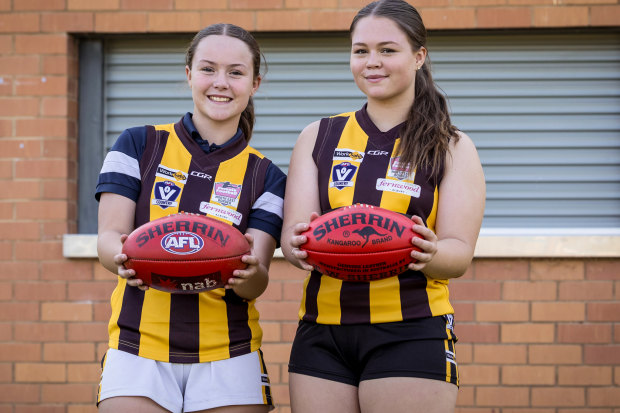
Cobram sisters Isabelle and Willow Foster play for Wangaratta.Credit: Jason Robins
Echuca Football Club president Justin Hatfield said concerns around youth girls “large age brackets” were justified, especially given the national spotlight on concussions and safety.
Justin says that while the AFL is focused on participation numbers, more time should be invested in fostering skill development.
“It seems like the AFL wants to get their numbers up. If they reach a certain target, then that’s a tick, which is why we see so many girls in Auskick. But there’s nowhere for these girls to go when they get older.”
AFL Goulburn Murray manager Shaun Connell is responsible for overseeing community football across the region.
He acknowledges the 13 to 17 age group as a “key gap”, but said the AFL was committed to reducing the travel barriers around women and girls’ footy in regional Victoria.
Shaun says the league is currently working towards decreasing the age bracket for youth girls teams and intends to introduce alternative forms of the game, such as AFL nines, to more communities.
“We are very conscious that we need to build the base of players at a lower age group level to ensure we have age-appropriate competitions as they [girls] continue their journey,” he says.
The AFL’s Women’s Football Vision states the game will strive for equal participation and representation in community football by 2030.
Shaun says the ultimate goal is for any regional player, male or female, to access footy within 30 minutes. “Our aim is to make the game accessible ... to continue to form those pathways for girls so that they can keep playing the sport they love.”
Old crossroads, a new team and a second chance
On a warm autumn afternoon at ‘the rec’ in Mansfield, a group of women huddle around the main oval, listening intently to Michael Bretherton, the club’s junior football president and their occasional coach.
One woman calls out: “When do we get our guernseys, Mick?”
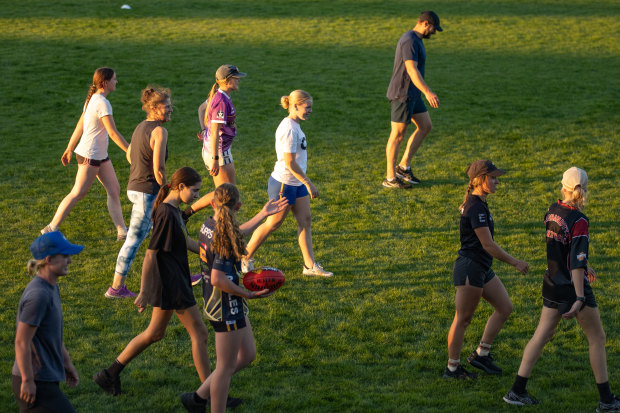
Members of the Mansfield women’s team at a training session.Credit: Simon Schluter
“They’re coming soon,” he promises. “Definitely in time for our first match.” The women respond with a chorus of whoops and cheers.
After nearly six months of campaigning, Mansfield has established a women’s side - the first in the club’s 143-year history. This afternoon is the team’s final training session before the Easter break and their excitement for their inaugural season is palpable.
The new team is made up of women over the age of 18, some have just finished high school while others work full-time.
Grace Preuss, 32, darts in and out of today’s training session, jogging over to the boundary line to breastfeed her 11-month-old daughter . Grace tried Auskick when she was younger but quit when she realised there were “zero future pathways”. A footy team in Mansfield has given her a second chance.
“It’s great to spend time with other mums while also prioritising fitness,” she says. “It’s been a long time coming.”
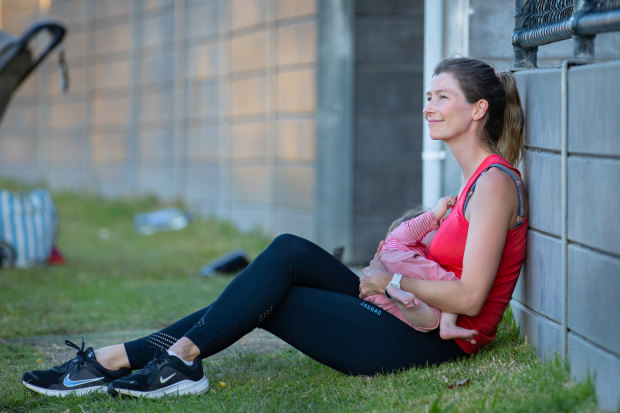
Grace Preuss takes a minute to breastfeed her daughter at footy training.Credit: Simon Schluter
A women’s side in the shire means Bonnie Doon’s Hannah Berriman can finally cease her long drives to Shepparton. This cuts her 80-minute commute to 20 for training. The 18-year-old says she’s happy to be back playing in her hometown, but admits her parents were “way more thrilled” than she was.
“It’s a lot less petrol,” she laughs.
Michael Bretherton says the formation of the team is a tribute to the community and AFL Goulburn Murray staff.
While the club still doesn’t have the numbers to pursue a youth girls’ side, he hopes one will be created within two years.
But the absence of a youth girls’ team means 13-year-old Phoebe Guppy is still at a crossroads. Travel over an hour to access footy in Wangaratta or Shepparton, or stop playing the game she loves.
Her mum is willing to get behind the wheel and do what it takes, and Phoebe is grateful.
“I love footy so much. I am not going to let it stop me.”
The Morning Edition newsletter is our guide to the day’s most important and interesting stories, analysis and insights. Sign up here.